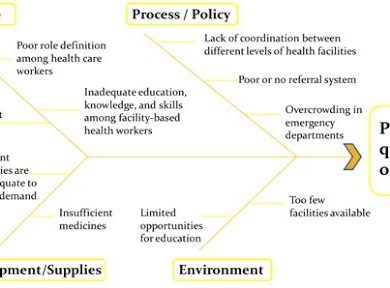
16 Risk Management practices to reduce malpractice & improve productivity
The Health Resources and Services Administration (HRSA), developed 16 risk management practices to reduce medical malpractice & ensure patient safety on the basis of documentation review & interview with various stakeholders.
Active quality improvement program: Organization should take internal efforts to improve the quality of care. These efforts may include reviewing clinical outcome data and conducting long-term projects aimed at improving clinical care.
Appropriate use of clinical protocols : Organization must establish step by step guidelines for providing clinical care to patients, that health care practitioners can use. These guidelines may be developed by professional organisations or by the health centre’s clinical staff.
Clear communication with patients : Patients must be given all the information about their care & treatment. Patients have a voice in determining their care and receiving information about their care in a way that they can comprehend. This includes providing translation services when necessary.
Clear communication with providers: Health care providers must receive clear communication from their leaders or managers about their roles and responsibilities and they must communicate clearly with each another.
Comprehensive patient medical records: All the care given to the patient in an healthcare setting must be mentioned in detailed in patients record. Patient record either paper or electronic must be well maintained.
Credentialing of health care professionals: This is the process of verifying that health care providers meet all required educational and licensing requirements. The health centre or a third party may conduct this activity.
Documentation of informed consent: Patients are adequately informed about risks and benefits of their treatment in form of informed consent.
Formal patient grievance mechanism: This is a system to collect, analyze, and address complaints received from patients and/or staff.
Internal incident reporting system: A system to collect and analyze information on adverse events that occur within the health centre resulting from inappropriate care.
Ongoing peer review of patient cases: The review of medical records or patient cases by health care professionals, either within the health centre or as outside consultants, to ensure that appropriate care was provided.
Onsite assessment of risks and risk management practices: A process to assess the potential risks of the health centre and the health centre’s activities to reduce its risks. This assessment can be done by the health centre or by outside consultants.
Patient tracking system: A formal system, either electronic or paper, to ensure that key patient information, such as test results, missed appointments, and care at different health care institutions, is not overlooked.
Privileging of health care professionals: The process of verifying, on a routine basis, that practitioners have the appropriate clinical competencies and the ability to perform clinical procedures effectively.
Regular patient satisfaction survey: A survey to assess patient satisfaction with the level of service and clinical care that they received.
Regular staff training on risk management: Staff receive either onsite or offsite training on topics related to risk management.
Up-to-date policies and procedures on risk management: Written documents that explicitly describe a health centre’s operations and processes related to risk management.
References:


No Comment